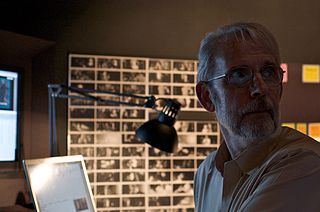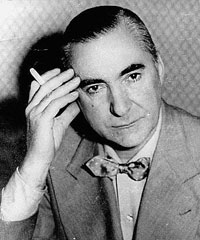Related Research Articles

Gian Galeazzo Ciano, 2nd Count of Cortellazzo and Buccari was an Italian diplomat and politician who served as Foreign Minister in the government of his father-in-law, Benito Mussolini, from 1936 until 1943. During this period, he was widely seen as Mussolini's most probable successor as head of government.

Walter Scott Murch is an American film editor, director, writer and sound designer. His work includes THX 1138, Apocalypse Now, The Godfather I, II, and III, American Graffiti, The Conversation, Ghost and The English Patient, with three Academy Award wins.

Curzio Malaparte, born Kurt Erich Suckert, was an Italian writer, filmmaker, war correspondent and diplomat. Malaparte is best known outside Italy due to his works Kaputt (1944) and The Skin (1949). The former is a semi-fictionalised account of the Eastern Front during the Second World War and the latter is an account focusing on morality in the immediate post-war period of Naples.

Casa Malaparte is a house on Punta Massullo, on the eastern side of the isle of Capri, Italy. It is considered to be one of the best examples of Italian modern and contemporary architecture.

Edda Ciano, Countess of Cortellazzo and Buccari was the daughter of Benito Mussolini, Italy's fascist dictator from 1922 to 1943. Her husband, the fascist propagandist and Foreign Minister Galeazzo Ciano, was executed in January 1944 for his role in Mussolini's ouster. She strongly denied her involvement in the National Fascist Party regime after her father's execution by the Italian partisans in April 1945.

The Iași pogrom was a series of pogroms launched by governmental forces under Marshal Ion Antonescu in the Romanian city of Iași against its Jewish community, which lasted from 29 June to 6 July 1941. According to Romanian authorities, over 13,266 people, or one third of the Jewish population, were massacred in the pogrom itself or in its aftermath, and many were deported. It was one of the worst pogroms during World War II.

Don Guido Colonna, dei principi di Paliano, noble of Rome, patrician of Naples and Venice was an Italian aristocrat, diplomat and European Commissioner.

The Skin is a 1981 Italian war film directed by Liliana Cavani and starring Marcello Mastroianni, Burt Lancaster, Ken Marshall, Carlo Giuffrè and Claudia Cardinale from Curzio Malaparte's book The Skin. It was entered into the 1981 Cannes Film Festival.

Finland–Spain relations are the diplomatic relations between the Republic of Finland and the Kingdom of Spain. Both nations are members of the Council of Europe, the European Union, the United Nations, the Schengen Area, the eurozone, and NATO. Diplomatic relations between the two countries have traditionally been good and fruitful and, at the same time, have consolidated an exchange at all levels. Spain is also one of the favorite destinations of Finnish tourism. Approximately ten percent of the Finnish population travels on vacation each year to Spain. Furthermore, the Finns are the fastest growing European community in Málaga, as Fuengirola is home to the second largest colony of Finns in the world, after Sweden.

Gruber's Journey or Călătoria lui Gruber is a 2008 Romanian drama film directed by Radu Gabrea. It is set in World War II during the Holocaust in Iași and was shot on location in Bucharest. The film screened at the Third Annual Romanian Film Festival.
The John Florio Prize for Italian translation is awarded by the Society of Authors, with the co-sponsorship of the Italian Cultural Institute and Arts Council England. Named after the Tudor Anglo-Italian writer-translator John Florio, the prize was established in 1963. As of 1980 it is awarded biannually for the best English translation of a full-length work of literary merit and general interest from Italian.

Anne Nivat is a French journalist and war correspondent who has covered conflicts in Chechnya, Iraq, and Afghanistan. She is known for interviews and character portraits in print of civilians, especially women, and their experiences of war.
Events from the year 1944 in Italy.
The Rašića Gaj massacres were massacres of Serbs committed by the Muslim Ustaše forces at the beginning of the World War II in Rašića Gaj, Vlasenica in Bosnia and Herzegovina in June and July 1941. The estimations of the number of Serbs killed in Rašića Gaj vary between at least 70 and 200. It was one of the most shocking early World War II war crimes for Serbs in Eastern Bosnia and the testimonies about the cruel slaughter of Serbs in Rašića Gaj spread among the population of the region, causing fear and anger among the Serbs.
Kaputt is a 1944 autobiographical novel by the Italian writer Curzio Malaparte.
The Skin is a 1949 autobiographical novel by the Italian writer Curzio Malaparte.
Coup d'État: The Technique of Revolution is a 1931 book by the Italian writer Curzio Malaparte.
Woman Like Me is a 1940 short story collection by the Italian writer Curzio Malaparte.
Those Cursed Tuscans is a 1956 book by the Italian writer Curzio Malaparte.
The Kremlin Ball is an unfinished novel by the Italian writer Curzio Malaparte, published posthumously in 1971.
References
- 1 2 Healey, Robin (2019). Italian Literature since 1900 in English Translation: An Annotated Bibliography: 1929–2016. Toronto Buffalo London: University of Toronto Press. p. 90. ISBN 978-1-4875-0292-8.
- ↑ T. S. (1958). "The Volga Rises in Europe. By Curzio Malaparte. Trans, by David Moore. London, Alvin Redman, 1957. 281 pp. 16s". International Affairs . 34 (3): 350. doi: 10.2307/2605154 .